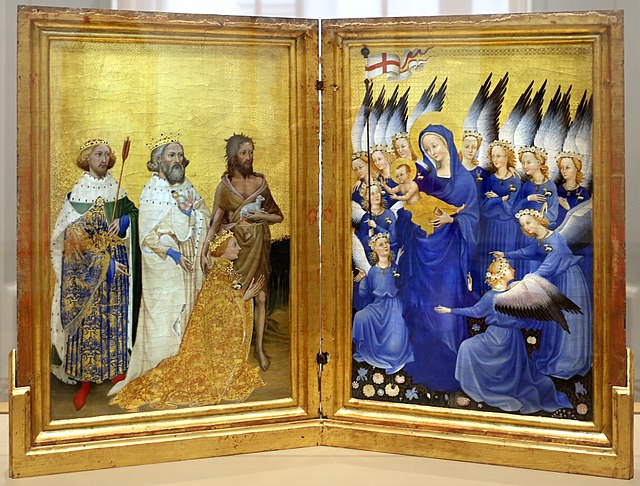The Wilton Diptych is a small portable diptych of two hinged panels, painted on both sides, now in the National Gallery, London. It is an extremely rare survival of a late medieval religious panel painting from England. The diptych was painted for King Richard II of England, who is depicted kneeling before the Virgin and Child in what is known as a donor portrait. He is presented to them by the English saints King Edmund the Martyr, King Edward the Confessor and patron saint, John the Baptist. The painting is an outstanding example of the International Gothic style, and the nationality of the unknown artist is probably French or English.
The Wilton Diptych, c. 1395–1399. Each panel is 53 cm × 37 cm (21 in × 15 in).
The outer sides of the diptych. Richard's arms (l.) and white hart emblem (r.)
The diptych panels in their golden frame at the National Gallery
The Dunstable Swan Jewel, a livery badge in ronde bosse enamel, about 1400. British Museum
A diptych is any object with two flat plates which form a pair, often attached by a hinge. For example, the standard notebook and school exercise book of the ancient world was a diptych consisting of a pair of such plates that contained a recessed space filled with wax. Writing was accomplished by scratching the wax surface with a stylus. When the notes were no longer needed, the wax could be slightly heated and then smoothed to allow reuse. Ordinary versions had wooden frames, but more luxurious diptychs were crafted with more expensive materials.
Ivory consular diptych of Areobindus, Byzantium, 506 AD, Louvre
Wax tablet and a Roman stylus
Barberini Ivory, Constantinople, 6th century, Louvre
Diptych with the Coronation of the Virgin and the Last Judgment, Metropolitan Museum of Art








